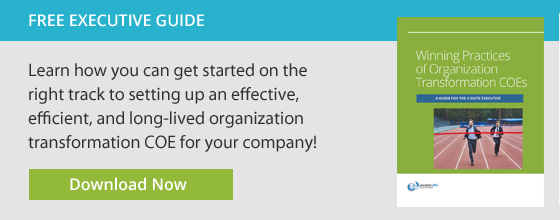Many companies are setting up internal centers of expertise (COE) to help do and manage the work of implementing organization change. Having these capabilities in house can be an efficient and cost effective way to manage change within an organization. However, COEs that operate in isolation or as a bolt-on to the organization often struggle to gain the traction needed and achieve desired results. To work effectively, an organization transformation COE must be set up to work harmoniously with other parts of the organization.
It is important to first define the purpose of the COE and ensure that it is in strategic alignment with the organization’s goals. Once that is accomplished, it is time to determine the right engagement model for your COE. There are three steps to consider in this process: role definition, determining resourcing and service levels, and prioritizing demand.
Step 1: Defining Clear Roles for Your Organization Transformation COE
Every large organization is home to many people and groups of people with specialized skills and expertise—Six Sigma Black Belts, HR business partners, other internal consulting groups, and so on. Many of these entities are also concerned with implementing organization change, and their roles and capabilities may overlap or touch on those offered by an organization transformation COE. To avoid conflict and ensure effective results, leaders must define clear roles for their COE that complement rather than conflict with existing roles and capabilities in the organization.
Take Six Sigma, for example. While the Six Sigma approach is not pure organization transformation, it’s related and utilizes many of the same capabilities related to work processes. Setting up an OE COE alongside an existing Six Sigma or Lean function risks creating an overlap in capabilities. This can inadvertently lead to internal competition and strife if care is not taken from the outset to clearly define whether and how the two functions will work together. At the same time, there may be multiple other overlaps with other groups or individuals (i.e. HR, change managers, etc.) within the organization.
I once attended a company division meeting regarding a proposed organization transformation, to which a number of internal as well as external consultants had been invited. There was a change manger, a process design expert, a business architect, an OE specialist from a COE, and several HR business partners, adding up to five or six different experts. Unfortunately, there was a lot of overlap in skills and expertise, and no one had taken the time beforehand to decide who would be responsible for what. The meeting ended up devolving in front of this division’s leaders into a discussion of who does what, who’s on first base, and who’s leading. Rather than instilling confidence that the organization transformation was well in hand by these experts, the division’s leaders felt unsure and frustrated as to whether the intended results would be achieved.
Play To Your Strengths
To be effective with your COE, it is necessary to figure out where its greatest strengths lie and what it will or will not be doing in light of what other specialists or groups in your company have to offer. If multiple specialties or sub-disciplines (e.g., organization design, change management, etc.) are needed on a change effort, it’s important to determine in advance who does what.
We worked with another client who was implementing organization change and engaged resources from their OE COE to help. There were two other related groups in the organization: a job design group and a group of process design experts. Rather than compete, these three parties got together and worked out in advance that in this case, the OE team would be responsible for the hands-on facilitation of the transformation design sessions. But when jobs needed to be designed and when processes needed to be mapped, the OE COE would call the appropriate group and have them come in just as a subcontractor might. They came in, did their specialty work, and when they were done the work would move forward as scoped and planned. That engagement model worked effectively because people understood their roles. They understood when they needed to come in and help, and when they were done no one got offended. While there are other ways to structure it, this is one example that worked.
Step 2: Determining Resourcing and Service Levels
One very common COE pitfall is for a mismatch to develop between the service level and the resourcing level. This often happens when COEs are successful at what they do.
A typical scenario is for an organization transformation COE to set itself up, define its scope and work, and be allotted a limited number of resources to execute and deliver services. If the COE is effective, the work starts to pile up. Before long, they find themselves juggling so many initiatives that they end up not doing any real work. Eventually this dynamic can cause a COE to fail.
There are a couple of ways to address this problem:
- Go back to step one and redefine (or refine) your scope and purpose
- Go to the organization and make the case for greater resource allocation based on the value the COE is delivering
It is better, however, to avoid falling into this trap in the first place. Maintaining and communicating clarity on what the COE is there to do, what they don’t do, who they are there to help, and how they partner with other internal (and external) resources to deliver value can help to minimize resource discrepancies.
Step 3: Prioritizing Demand
This then leads to the question of how to go about prioritizing requests or regulating demand for services offered. A COE that treats all prospective customers equally and/or says ‘yes’ to all requests will typically always be short on resources. It is, therefore, important to develop some kind of objective approach to govern which types of projects and/or customers take priority, as well as to clearly communicate this approach.
Every organization approaches this a little differently. Some organization transformation COEs prioritize corporate initiatives over requests from regional or business unit leaders. Sometimes, the opposite is true. The key is to set criteria and define the intake mechanisms for identifying needs (demand) and allocating resources to work on it.
3 Key Questions to Assist in Determining Your COE Engagement Model
Determining the answers to these three questions from the get go will help ensure that your organization transformation COE operates smoothly and harmoniously within your organization.
- How will the COE work or partner with other internal parties/groups (e.g., HRBPs, Change Managers, Black Belts, etc.)
- How will service levels and resourcing levels be determined?
- How will requests (demand) be prioritized?

